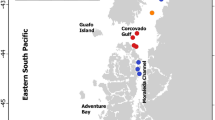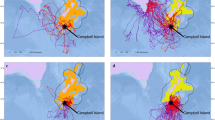Abstract
Fishing is well known to curtail the size distribution of fish populations. This paper reports the discovery of small-scale spatial patterns in length appearing in several exploited species of Celtic Sea demersal ‘groundfish’. These patterns match well with spatial distributions of fishing activity, estimated from vessel monitoring records taken over a period of 6 years, suggesting that this ‘mobile’ fish community retains a persistent impression of local-scale fishing pressure. An individual random-walk model of fish movement best matched these exploitation ‘footprints’ with individual movement rates set to <35 km per year. We propose that Celtic Sea groundfish may have surprisingly low movement rates for much of the year, such that fishing impact is spatially heterogeneous and related to local fishing intensity.





Similar content being viewed by others
References
Bendall VO, O’Cuaig M, Schon P-J, et al. (2009) Spatio-temporal dynamics of Atlantic cod (Gadus morhua) in the Irish and Celtic Sea: results from a collaborative tagging programme. ICES Doc. C. 2009/J 06. 35 pp
Bolle LJ, Hunter E, Rijnsdorp AD et al (2005) Do tagging experiments tell the truth? Using electronic tags to evaluate conventional tagging data. ICES J Mar Sci 62:236–246
Botsford LW, Brumbaugh DR, Grimes C et al (2009) Connectivity, sustainability, and yield: bridging the gap between conventional fisheries management and marine protected areas. Rev Fish Biol Fish 19:69–95
Brown JH, Mehlman D, Stevens GC (1995) Spatial variation in abundance. Ecology 76:2028–2043
Chapman BB, Skov C, Hulthén K et al (2012) Partial migration in fishes: definitions, methodologies and taxonomic distribution. J Fish Biol 81:479–499
De Pontual H, Bertignac M, Battaglia A et al (2003) A pilot tagging experiment on European hake (Merluccius merluccius): methodology and preliminary results. ICES J Mar Sci 60:1318–1327
Farnsworth KD, Beecham JA (1999) How do grazers achieve their distribution? A continuum of models from random diffusion to the ideal free distribution using biased random walks. Am Nat 153:509–526
Foley MM, Halpern BS, Micheli F et al (2010) Guiding ecological principles for marine spatial planning. Mar Policy 34:955–966
Fraser HM, Greenstreet SPR, Piet GJ (2007) Taking account of catchability in groundfish survey trawls : implications for estimating demersal fish biomass. ICES J Mar Sci 64:1800–1819
Gerritsen H, Lordan C (2011) Integrating vessel monitoring systems (VMS) data with daily catch data from logbooks to explore the spatial distribution of catch and effort at high resolution. ICES J Mar Sci 68:245–252. doi:10.1093/icesjms/fsq137
Gerritsen HD, Minto C, Lordan C (2013) How much of the seabed is impacted by mobile fishing gear? Absolute estimates from Vessel Monitoring System (VMS) point data. ICES J Mar Sci 70:523–531
Grove M (2013) The evolution of spatial memory. Math Biosci 242:25–32
Grüss A, Kaplan DM, Guénette S et al (2011) Consequences of adult and juvenile movement for marine protected areas. Biol Conserv 144:692–702
Hinz H, Kaiser MJ, Bergmann M et al (2003) Ecological relevance of temporal stability in regional fish catches. J Fish Biol 63:1219–1234
Homrum E, Hansen B, Jónsson S et al (2013) Migration of saithe (Pollachius virens) in the Northeast Atlantic. ICES J Mar Sci 70:782–792
Huntingford FA (2005) Can cost-benefit analysis explain fish distribution patterns? J Fish Biol 43:289–308
Huse I, Løkkeborg S, Soldal AV (2000) Relative selectivity in trawl, longline and gillnet fisheries for cod and haddock. ICES J Mar Sci 57:1271–1282
Kaiser MJ, Clarke KR, Hinz H et al (2006) Global analysis and prediction of the response of benthic biota and habitats to fishing. Mar Ecol Prog Ser 311:1–14
Knutsen H, Jorde PE, André C, Stenseth NC (2003) Fine-scaled geographical population structuring in a highly mobile marine species: the Atlantic cod. Mol Ecol 12:385–394
Laurenson CH, Johnson A, Priede IG (2005) Movements and growth of monkfish Lophius piscatorius tagged at the Shetland Islands, northeastern Atlantic. Fish Res 71:185–195
MacDonald PDM, Pitcher TJ (1979) Age-groups from size-frequency data: a versatile and efficient method of analyzing distribution mixtures. J Fish Res 36:987–1001
Metcalfe JD (2006) Fish population structuring in the North Sea: understanding processes and mechanisms from studies of the movements of adults. J Fish Biol 69:48–65. doi:10.1111/j.1095-8649.2006.01275.x
Moland E, Olsen EM, Knutsen H et al (2013) Lobster and cod benefit from small-scale northern marine protected areas: inference from an empirical before—after control-impact study. Proc R Soc B 280:20122679
Morsan E (2007) Spatial pattern, harvesting and management of the artisanal fishery for purple clam (Amiantis purpurata) in Patagonia (Argentina). Ocean Coast Manag 50:481–497
Neat FC, Wright PJ, Zuur AF et al (2006) Residency and depth movements of a coastal group of Atlantic cod (Gadus morhua L.). Mar Biol 148:643–654. doi:10.1007/s00227-005-0110-6
Neat FC, Bendall V, Berx B et al (2014) Movement of Atlantic cod around the British Isles: implications for finer scale stock management. J Appl Ecol 51:1564–1574. doi:10.1111/1365-2664.12343
Pelletier D, García-Charton JA, Ferraris J et al (2005) Designing indicators for assessing the effects of marine protected areas on coral reef ecosystems: a multidisciplinary standpoint. Aquat Living Resour 18:15–33
Pinsky ML, Palumbi SR, Andréfouët S, Purkis SJ (2012) Open and closed seascapes: where does habitat patchiness create populations with high fractions of self-recruitment? Ecol Appl 22:1257–1267
Reid DG, Allen VJ, Bova DJ et al (2007) Anglerfish catchability for swept-area abundance estimates in a new survey trawl. ICES J Mar Sci 64:1503–1511
Reiss H, Degraer S, Duineveld GC et al (2010) Spatial patterns of infauna, epifauna, and demersal fish communities in the North Sea. ICES J Mar Sci 67:278–293
Righton D, Quayle VA, Hetherington S, Burt G (2007) Movements and distribution of cod (Gadus morhua) in the southern North Sea and English Channel: results from conventional and electronic tagging experiments. J Mar Biol Assoc UK 87:599–613
Robichaud D, Rose GA (2004) Migratory behaviour and range in Atlantic cod: inference from a century of tagging. Fish Fish 5:185–214. doi:10.1111/j.1467-2679.2004.00141.x
Rodríguez-Cabello C, Sánchez F, Fernández A, Olaso I (2004) Is the lesser spotted dogfish (Scyliorhinus canicula) population from the Cantabrian Sea a unique stock? Fish Res 69:57–71
Scientific T and EC for F (STECF) (2013) Evaluation of fishing effort regimes in European waters—Part 2 (STECF-13-21). Luxembourg, EUR 26327 EN, JRC86088
Sell AF, Kröncke I (2013) Correlations between benthic habitats and demersal fish assemblages—a case study on the Dogger Bank (North Sea). J Sea Res 80:12–24
Shephard S, Gerritsen HD, Kaiser MJ et al (2011) Fishing and environment drive spatial heterogeneity in Celtic Sea fish community length-structure. ICES J Mar Sci 68:2106–2113
Shephard S, Fung T, Houle JE et al (2012a) Size-selective fishing drives species composition in the Celtic Sea. ICES J Mar Sci 69:223–234. doi:10.1093/icesjms/fsr200
Shephard S, Gerritsen H, Kaiser MJ, Reid DG (2012b) Spatial heterogeneity in fishing creates de facto refugia for endangered Celtic Sea elasmobranchs. PLoS ONE 7:e49307. doi:10.1371/journal.pone.0049307
Smith BE, Collie JS, Lengyel NL (2013) Effects of chronic bottom fishing on the benthic epifauna and diets of demersal fishes on northern Georges Bank. Mar Ecol Prog Ser 472:199–217
Tobin D, Wright PJ, Gibb FM, Gibb IM (2010) The importance of life stage to population connectivity in whiting (Merlangius merlangus) from the northern European shelf. Mar Biol 157:1063–1073
Acknowledgments
This study used survey data supplied the Irish Marine Institute. S.S. was funded from the European Community’s Seventh Framework Programme (FP7/2007–2013) under grant agreement MYFISH no 289257. S.B.M.K. was funded through a fellowship (Grant-Aid Agreement No. PDOC/FS/07/002) funded by the Sea Change Strategy with the support of the Marine Institute and the Marine Research Sub-programme of the National Development Plan 2007–2013, Ireland. F. de C., K.D.F. and D.G.R. acknowledge support through a Beaufort Marine Research Award, carried out under the Sea Change Strategy and the Strategy for Science Technology and Innovation (2006–2013), with the support of the Marine Institute, funded under the Marine Research Sub-programme of the Irish National Development Plan 2007–2013. We appreciate the suggestions of the four anonymous reviewers that helped improve the manuscript.
Conflict of interest
The authors declare that they have no conflict of interest.
Informed consent
Informed consent was obtained from all individual participants included in the study.
Author information
Authors and Affiliations
Corresponding author
Additional information
Communicated by M.Peck.
Electronic supplementary material
Below is the link to the electronic supplementary material.
Rights and permissions
About this article
Cite this article
de Castro, F., Shephard, S., Kraak, S.B.M. et al. Footprints in the sand: a persistent spatial impression of fishing in a mobile groundfish assemblage. Mar Biol 162, 1239–1249 (2015). https://doi.org/10.1007/s00227-015-2665-1
Received:
Accepted:
Published:
Issue Date:
DOI: https://doi.org/10.1007/s00227-015-2665-1




